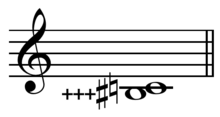

In music theory, a comma is a very small interval, the difference resulting from tuning one note two different ways.[1] Traditionally, there are two most common comma; the syntonic comma, "the difference between a just major 3rd and four just perfect 5ths less two octaves", and the Pythagorean comma, "the difference between twelve 5ths and seven octaves".[2] The word comma used without qualification refers to the syntonic comma,[3] which can be defined, for instance, as the difference between an F♯ tuned using the D-based Pythagorean tuning system, and another F♯ tuned using the D-based quarter-comma meantone tuning system. Intervals separated by the ratio 81:80 are considered the same note because the 12-note Western chromatic scale does not distinguish Pythagorean intervals from 5-limit intervals in its notation. Other intervals are considered commas because of the enharmonic equivalences of a tuning system. For example, in 53TET, B![]() ♭ and A♯ are both approximated by the same interval although they are a septimal kleisma apart.
♭ and A♯ are both approximated by the same interval although they are a septimal kleisma apart.
- ^ Waldo Selden Pratt (1922). Grove's Dictionary of Music and Musicians, Vol. 1, p. 568. John Alexander Fuller Maitland, Sir George Grove, eds. Macmillan.
- ^ Clive Greated (2001). "Comma", Grove Music Online. doi:10.1093/gmo/9781561592630.article.06186
- ^ Benson, Dave (2006). Music: A Mathematical Offering, p. 171. ISBN 0-521-85387-7.